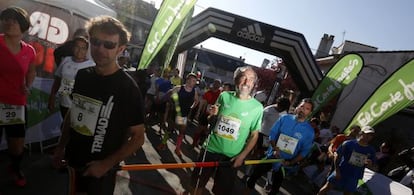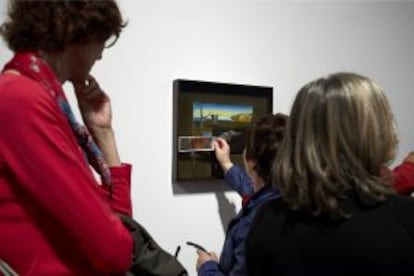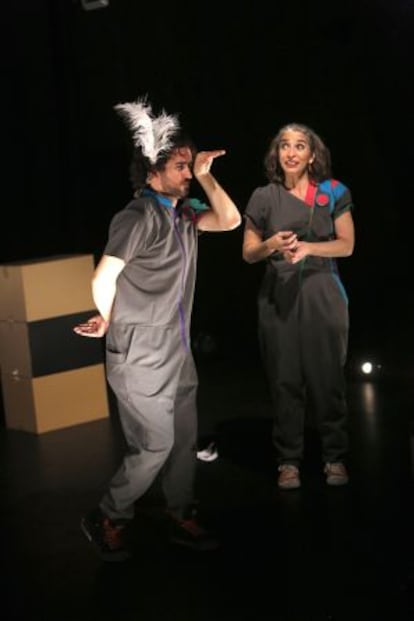The Madrid art of accessibility
The capital offers a range of cultural and sporting activities for the visually and hearing impaired Sign language plays, touchable paintings and adapted mountain races are among the innovations

Madrid’s first, and so far only, disco adapted to the needs of the deaf ran for less than six months in the first half of 2013. Christian Gordo, who was born deaf, says he never had the chance to attend. “It only opened on Thursdays, between nine and two in the morning: a club that doesn’t open at weekends just doesn’t make sense,” says the 36-year-old.
Speaking rapidly using sign language that his girlfriend translates, Gordo says the Spanish capital still largely excludes people with hearing or visual disabilities from its cultural life, which is why he decided to become an actor: “I want to show that it is possible for us to be involved in the arts scene,” he says after taking part in a play called Mano a mano (Hand to hand) at the tiny Kubik theater in the working-class district of Usera, in the southwest of the city.
Gordo says he has always enjoyed acting, and decided to enter the profession in his late teens. Since then he has been acting out his roles using sign language. In Mano a mano, which he wrote, he performs with Marga Labarga, who has full hearing – the pair talk and use sign language simultaneously. “This allows the audience, and particularly children, to enjoy theater, regardless of their disability,” he says.
He developed his approach to acting with the pioneering Teatro Accesible, which was set up to adapt theater to the needs of the deaf. “We want the deaf to be able to attend theater just like everybody else, with family and friends,” says the group’s Beatriz Leronés. Teatro Accesible was set up with funding from cellphone company Vodaphone, along with NGO Psiquiatría y Vida, and Aptent: Be Accessible, a company set up to increase the deaf community’s access to theater.

Two of Madrid’s main theaters, the María Guerrero and Vallé-Inclán – both part of Spain’s National Theater – are particularly active in involving the deaf community, providing specially adapted earphones, or on occasions, subtitles and sign-language translators just off stage.
Funded by ONCE, Spain’s National Organization for the Blind, La Luciérnaga has led the way in providing an outlet for the visually impaired. It was set up 30 years ago and regularly stages productions. On June 21, it will be performing in the small village of Moralzarzal, close to El Escorial, around 50 kilometers northwest of the capital. El Grito, made up of actors who perform using sign language, also campaigns to give the deaf a voice in theater.
While some progress is being made to open the doors of Madrid’s theaters to the deaf, the same cannot be said of the capital’s cinemas. “I go to original version movies at the Ideal, but they are all foreign. If I want to see Spanish films, I have a problem: they aren’t subtitled,” says Gordo. The only movie theater adapted to the needs of the deaf and blind is the Dreams-Palacio de Hielo, in the northern suburb of Hortaleza. Isaac Dorrego, the cinema’s manager, says not all movies are released in formats suitable for the deaf or blind: “It’s up to the distributors and the production company, and they don’t always provide subtitles or audio-descriptions.” The movie theater’s system is simple: it has a monitor just under the main screen that transmits subtitles. Blind people are given wireless headphones. “These are free and do not bother other people, and so it makes the whole thing feel much more normal,” says Dorrego, noting that the cinema will be showing hit Spanish comedy Ocho apellidos vascos on May 29.
Slowly but surely, the capital’s museums and art galleries are also responding to the needs of the visually impaired. Santiago González, the coordinator of the Reina Sofía Museum, says the deaf or people with hearing problems can request a sign language interpreter to accompany them on a guided tour of its art collection: “We feel that this makes the whole experience more participative, rather than sending groups of deaf people round on their own.”

The Reina Sofía also offers guided tours for the blind and visually impaired. These can take the form of exploring sculptures by touching them, or in the case of paintings, getting to know them through a detailed oral description while feeling the outline of the work on a sheet of plastic featuring its main elements in relief.
Madrid’s blind community also has its own museum, the Museo Tiflológico, which includes works of art that can be handled, along with small-scale replicas of some of the world’s most important buildings and structures, such as the Taj Mahal and the Eiffel Tower. There is also a collection of works by visually impaired artists.
The blind are also increasingly able to take part in sporting activities, thanks in large part to the work of the Spanish Sports Federation for the Blind. Ismael Martínez, a philosophy lecturer at Madrid’s Complutense University, lost his sight at the age of 10. Six years ago, at the age of 49, he decided to take up mountain running. “The feeling of freedom, of dignity, is marvelous,” he explains.
Using a special stabilizing bar, he now takes part in races with sighted runners, and with the help of two guides is able to complete the courses in good time.
Spain developed the system that allows blind people to take part in mountain running 20 years ago, says Francis Bueno of ONCE. “We use a special stick that is two or three meters long that connects the runner with a guide in front and one behind,” says Darío Carreras of the Spanish Sports Federation for the Blind.
The system means that Spanish blind runners are able to take part in events that sometimes last up to eight hours in this country and abroad. “In Madrid we go out at least once a month, and there is always a big turnout,” says Carreras, who says the sport has proved one of the most effective ways of bringing the sighted into contact with the visually impaired. What you might call leveling the playing field.







































